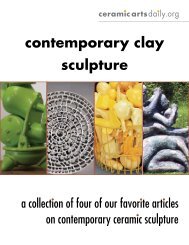Narrative Cycles on the Hagia Triada Sarcophagus - Wendy Walgate
Narrative Cycles on the Hagia Triada Sarcophagus - Wendy Walgate
Narrative Cycles on the Hagia Triada Sarcophagus - Wendy Walgate
- No tags were found...
Create successful ePaper yourself
Turn your PDF publications into a flip-book with our unique Google optimized e-Paper software.
pieces and parts of a female figurine. These items, which were of Cretan origin, may have beencerem<strong>on</strong>ial or part of <strong>the</strong> grave goods of <strong>the</strong> deceased. 5Although <strong>the</strong> scenes <strong>on</strong> <strong>the</strong> HTS do not specifically depict mourning processi<strong>on</strong>s orpro<strong>the</strong>sis scenes as <strong>on</strong> Mycenaean larnakes, <strong>the</strong> presence of b<strong>on</strong>es in a tomb-like structure withgrave goods suggest that <strong>the</strong> HTS was an object associated with burial. The imagery <strong>on</strong> <strong>the</strong>surface might <strong>the</strong>refore reflect natural and supernatural scenes associated with Minoan beliefsabout death. The relatively sophisticated fresco painting technique and use of limest<strong>on</strong>e in <strong>the</strong>c<strong>on</strong>structi<strong>on</strong> of <strong>the</strong> HTS may link it to a wealthier, perhaps prominent level of society. 6Unlike Egyptian sarcophagi, Minoan larnakes usually had a series of holes drilled in <strong>the</strong>bottom, perhaps to allow bodily fluids to drain off or <strong>the</strong> tissues to desiccate. While <strong>the</strong>painstaking mummificati<strong>on</strong> of Egyptian dead suggests a belief in a type of physical resurrecti<strong>on</strong>in <strong>the</strong>ir afterlife, Minoan culture is thought to have minimized <strong>the</strong> importance of <strong>the</strong> physicalbody. After decompositi<strong>on</strong>, Minoan b<strong>on</strong>es were apparently removed ei<strong>the</strong>r to <strong>on</strong>e side of <strong>the</strong>sarcophagus, <strong>on</strong>to <strong>the</strong> floor of <strong>the</strong> tomb itself, or simply accumulated into ano<strong>the</strong>r larnax which<strong>the</strong>n served as ossuary. 7Literal Reading of Directi<strong>on</strong> - Chart 1Since <strong>the</strong> North and East sides of <strong>the</strong> HTS were found facing <strong>the</strong> door of <strong>the</strong> tombstructure, L<strong>on</strong>g labels <strong>the</strong> north side <strong>the</strong> “fr<strong>on</strong>t”. This face is <strong>the</strong> <strong>on</strong>e most frequently illustratedin o<strong>the</strong>r studies of <strong>the</strong> HTS. L<strong>on</strong>g’s usage of compass points to name <strong>the</strong> sides is adopted for <strong>the</strong>purpose of this essay, ra<strong>the</strong>r than <strong>the</strong> potentially hierarchical “fr<strong>on</strong>t” and “back” labels. In <strong>the</strong>writer’s view, <strong>the</strong> use of <strong>the</strong> “fr<strong>on</strong>t” as <strong>the</strong> more “popular” illustrati<strong>on</strong> of <strong>the</strong> HTS reinforces an5 L<strong>on</strong>g, Ayia 14.6 Fragments from st<strong>on</strong>e sarcophagi were found at Kefallenia and Cyprus. L<strong>on</strong>g, Ayia 16.7 L<strong>on</strong>g, Ayia 18.3





